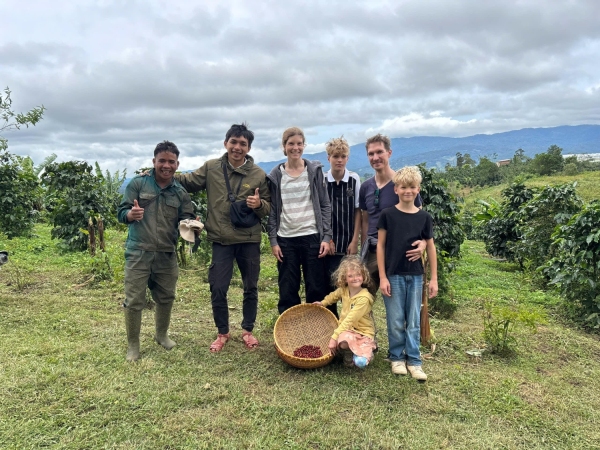
To be truly self-sufficient in organic farming, we started by raising a few cows to produce compost for our fields.
However, taking care of them was far more demanding than expected—three meals a day, early morning, noon, and late evening. Every meal was marked by a long, deep moo as they signaled their hunger.
Since our land was sloping, we had to cut fresh grass manually or lead them to a nearby grazing spot. It was a fun experience, but also a profound realization of how much effort farmers invest in livestock care.


Our first step toward sustainability was eliminating herbicides—but that also meant cutting the grass by hand.
🌧 The rainy season:
✔ Weeds grow back rapidly within a month
✔ Requires high labor effort and additional costs to control
☀️ The dry season:
✔ Weed layers act as natural mulch, improving soil moisture retention
✔ No need for frequent weed control

Years of chemical overuse had left our land dry and nutrient-poor in the dry season—but during rainy months, it softened, allowing weeds to grow abundantly.
To improve soil quality, we:
✔ Covered the land strategically
✔ Planted small patches of vegetables for self-sustenance

Biodiversity is key to sustainability, so we planted bananas to:
✔ Moisturize the soil
✔ Regenerate nutrients
✔ Detoxify the land
✔ Allow intercrops like vegetables to thrive

When we decided to open our farmstay, we knew it wouldn’t be easy—but nothing prepared us for the reality of welcoming our first guests.
Our farm was located 2km from the main road, accessible only by a dirt path. On rainy days, the road transformed into a muddy trail—some visitors had to trudge through ankle-deep mud, their shoes sinking into the earth as they arrived.
Inside, we did our best to convert an old grocery store into a cozy guest room. It was small, rustic, yet clean—because I believed cleanliness was a matter of professional ethics, even in the simplest of spaces.
I priced the room at $10 per night on Airbnb—the lowest I could set. But that $10 meant everything:
✅ It equaled two full banana bunches, cultivated for a year
✅ It was worth 30kg of pumpkins, harvested through heavy rains
✅ It represented the effort behind countless vegetables and fruits
Despite my limited English, I eagerly listened, using Google Translate to communicate each sentence. What mattered was not perfect grammar—but the shared passion for sustainable farming that united us, beyond any language barrier.



As small-scale farmers without access to large sustainability grants, we sought alternative income sources:
✔ Growing vegetables for food & selling fruits
✔ Offering eco-farm accommodations for visitors

Despite treating our coffee with respect and care, the market didn’t accept it.
🚚 Out of 3,000 kg harvested, only 50 kg were sold—the rest was liquidated to big companies for cheap instant coffee production.
Sitting on the truck loaded with bags of coffee that we had worked so hard to produce, we looked at each other—and said nothing.

While pursuing sustainable coffee farming, we embraced traditional farming wisdom:
✔ Local farmers guided us on planting techniques
✔ Optimizing yield for long-term stability
✔ Balancing sustainability with practical farming needs
Ultimately, stability in yield means stability in life—ensuring farmers can afford food, send their children to school, and secure a better future.

💡 Explore organic coffee crafted with care
✅ Hand-picked, ethically grown coffee
✅ Eco-friendly practices improving soil & biodiversity
✅ On-farm experiences to witness sustainable coffee production firsthand
🔗 Browse our coffee selection: HuyEco Coffee Collection
🔗 Visit our farm & coffee tour: Eco-Friendly Coffee Farm Tour
👉 Order HuyEco Coffee
Coffee grown, harvested, and processed at HuyEco—sustainably crafted from soil to sip.
👉 Book an Eco Coffee Tour
Visit the farm, walk the muddy path, pick coffee cherries, and brew your own cup.
👉 About HuyEco Farm
From depleted soil to a self-sufficient farm—our story of honest farming and sustainable living.
👉 Blog: Sustainable Coffee Farming – A Personal Journey
Another story from HuyEco—about choosing to grow coffee slowly, not cheaply.
👉 IFOAM – Principles of Organic Agriculture
The four core principles of organic farming, as defined by the global IFOAM organization.
👉 FAO – The Role of Organic Fertilizer in Soil Health
FAO explains how compost and organic inputs help restore soil fertility and structure.
👉 Airbnb – Agritourism Experiences
Airbnb’s curated collection of farm-based stays and hands-on rural experiences.
Reader Comments
Newer articles
 Sustainable Coffee & Local Culture Tour in Da Lat — Arabica, Robusta & Ethical Farming
Sustainable Coffee & Local Culture Tour in Da Lat — Arabica, Robusta & Ethical Farming
 Discover Sustainable Coffee in Da Lat — A Farm-to-Cup Journey with HuyEco
Discover Sustainable Coffee in Da Lat — A Farm-to-Cup Journey with HuyEco
 Sustainable Coffee and Local Farming Realities in Da Lat HuyEc
Sustainable Coffee and Local Farming Realities in Da Lat HuyEc
 From Forest to Cup: A Personal Journey into Sustainable Coffee in Da Lat
From Forest to Cup: A Personal Journey into Sustainable Coffee in Da Lat
 Inside HuyEco: How a Coffee Huller Machine Transformed Our Coffee Production
Inside HuyEco: How a Coffee Huller Machine Transformed Our Coffee Production
 From Forest to Cup: A Farmer’s Vision for Sustainable Coffee and Local Travel in Da Lat
From Forest to Cup: A Farmer’s Vision for Sustainable Coffee and Local Travel in Da Lat
 Field Notes from Xã Lát: Rooted in Regenerative Coffee & Indigenous Farming
Field Notes from Xã Lát: Rooted in Regenerative Coffee & Indigenous Farming
 Đưng K'Nớ: Brewing Sustainable Coffee in Vietnam’s Highland Forest
Đưng K'Nớ: Brewing Sustainable Coffee in Vietnam’s Highland Forest
 Living Coffee Ecosystem in Da Lat – HuyEco’s Way of Growing
Living Coffee Ecosystem in Da Lat – HuyEco’s Way of Growing
 Nel Drip & Wabi-Sabi: Japanese Coffee Rituals at HuyEco Da Lat
Nel Drip & Wabi-Sabi: Japanese Coffee Rituals at HuyEco Da Lat